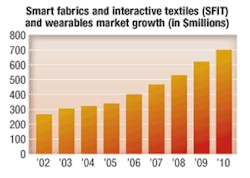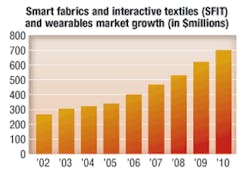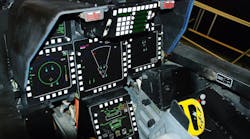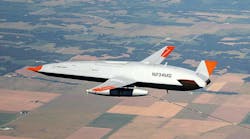The smart fabrics and interactive textiles (SFIT) and wearables markets is roughly $400 million today in fragmented, unprofitable revenue, and may reach $700 million in break-even or marginally profitable revenue by 2010, say analysts at Venture Development Corp. (VDC) in Natick, Mass.
SFIT and wearables refer to textiles with wearable computing, augmented reality, human-machine interfaces, media and interface design, and the collaboration between established electronics and textile industries.
Smart clothing usually involves either:
- clothes with sensors or devices in pocket or in fabric such as microcomputers, flexible TV screens, micro cellular phones, solar cells, energy recovery systems and flexible keyboards; or
- smart clothes with sensors close to, or in contact with, the skin, which are more used for body sensing and monitoring. The sensors are enclosed in the layers of fabric, or it is the fabric itself which is used as sensors. Such sensors can be piezo-resistive yarns, optic fibers, and colored multi layers.
Smart clothing with electronics in pocket or in fabric primarily are for communications, displaying colors, pictures, indications of mood, or messages. Devices or sensors like GPS systems, fall detectors, data loggers, or accelerometer and activity detectors, can be in special pockets or attached in the garment.
Smart clothing with sensors or near to the skin is for body sensing and monitoring. The sensors are enclosed in the layers of fabric, or the fabric itself acts as sensors.
One example of smart clothing, VDC points out, is the Hug Shirt from CuteCircuit Ltd. in London, which incorporates conductive Lycra fibers into its platform fabric. The conductive fibers digitize pressure sensations of an actual, physical hug, and send those signals via a wireless network to another Hug Shirt wearer such that both parties can feel a hug.
The press coverage was sufficient to generate significant demand from consumers, retailers, the military—troops requested them to keep in touch with loved ones at home—and from medical/health care providers. CuteCircuit is looking to get the Hug Shirt into retail outlets for sale by the end of 2007.
Although VDC believes the Hug Shirt will likely be more of a novelty item, the application of digitizing biophysical monitoring data, transmitting it and applying it provides huge market opportunities in several segments.
This combined SFIT and wearables market has the potential to earn margin-rich billions in the years ahead, VDC analysts say.
Even though the SFIT and wearables markets are clearly out of the viability stage of their development, and neither market has yet achieved consistent profitability, both markets are growing and creating a growing number of opportunities for investors, developers, suppliers, and their customers, analysts say.
VDC experts also highlight the importance of incorporating design and innovation early in the process as a strategic weapon in gaining competitive advantage; photovoltaic fibers may serve as an alternative power source and could be used with new battery technology; and coming military applications and solutions could make significant contributions to battlefield safety, survivability, and productivity.
For more information, contact VDC online at www.vdc-corp.com.




